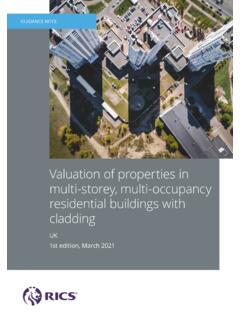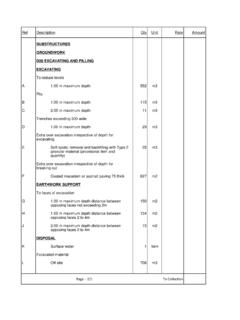Transcription of 0331 Brick and block construction - NATSPEC
1 0331 brick and block construction NATSPEC DOMESTIC 46 "[insert date]" 0331 brick and block construction This worksection has been written for Class 1 and 10a buildings that fully conform to the scope of AS If the works include isolated structures, (totally separate from the main conforming building), that do not conform to the scope of AS , include the references to AS 3700 as noted in Guidance. If the buildings do not conform to the scope of AS delete all references to AS in the specification and change the specification to references AS 3700, as noted in the Guidance. Retaining walls: Consult the local approval authority to determine where walls over a certain height require design by a professional engineer. Energy efficiency requirements at BCA set out minimum insulation performance requirements for walls, roofs, floor slabs and external glazing depending on climate zone and orientation.
2 1 GENERAL STANDARDS General Materials and construction : To AS and AS For isolated structures not conforming to the scope of AS 4773 series amend to AS 3700. 2 PRODUCTS DURABILITY General Exposure environment: [complete/delete] Select exposure environment from: mild, moderate, industrial, marine or severe marine to AS clause Exposure environment is project specific and applies to all masonry materials, accessories and built-in items. Exposure locations: To AS clause There might be different exposure locations within one project: exterior, exterior-coated or interior. Nominate in SELECTIONS or show in the drawings. For isolated structures not conforming to the scope of AS 4773 series amend to AS 3700 clause MATERIALS Bricks and blocks Standard: To AS/NZS and AS/NZS Minimum age of clay bricks: 7 days.
3 Salt attack resistance grade: To AS Table For isolated structures not conforming to the scope of AS 4773 series amend to AS 3700 Table Problems are being experienced with salt attack on brickwork below damp-proof course level on sites which had once been heavily fertilised. Exposure class bricks are normally readily available for such locations. Mortar materials Sand: Fine aggregate with a low clay content and free from efflorescing salts, selected for colour and grading. Proportions: To AS Table BUILT-IN COMPONENTS General Durability class of built-in components: To AS Table For isolated structures not conforming to the scope of AS 4773 series amend to AS 3700 Table Steel lintels Angles and flats: Sizes to AS Table Cold-formed lintels: Designed to AS/NZS 4600.
4 Corrosion protection: To AS/NZS Galvanizing: Do not cut after galvanizing. 0331 brick and block construction NATSPEC DOMESTIC 47 "[insert date]" Wall ties Standard: To AS/NZS Type: A. Corrosion protection: To AS/NZS Connectors and accessories Standard: To AS/NZS Corrosion protection: To AS/NZS Flashings and damp-proof courses Standard: To AS/NZS 2904. For suitable flashings and DCP material see AS Table 3 EXECUTION GENERAL Mortar mixing General: Measure volumes accurately to the documented proportions. Machine mix for at least six minutes. Protection from contamination General: Protect masonry materials and components from ground moisture and contamination. Bond Type: Stretcher bond. Building in Embedded items: Build in wall ties and accessories as the construction proceeds.
5 If it is not practicable to obtain the required embedment wholly in the mortar joint in hollow masonry units, fill appropriate cores with grout or mortar. Clearance for timber frame shrinkage General: In timber frame Brick veneer construction , leave clearances between window frames and Brick sill and between roof frames and the Brick veneer as follows: - Additional clearance: Accommodate additional shrinkage of unseasoned floor timbers. - Single storey frames and ground floor windows (not for slab on ground): 10 mm. - Two storey frames and upper floor windows: 20 mm. Joining to existing General: Provide a control joint where joining to existing structures. Do not tooth new masonry into existing work unless approved by a professional engineer. Mortar Joints Solid and cored units: Lay on a full bed of mortar.
6 Fill perpends solid. Cut mortar flush. Face-shell bedded hollow units: Fill perpends solid. Cut mortar flush. Finish: Conform to the following: - Externally: Tool to give a dense water-shedding finish. - Internally: If wall is to be plastered, do not rake more than 10 mm to give a key. - Thickness: 10 mm. Cutting: Set out masonry with joints of uniform width and the minimum of cutting of masonry units. For jointing, see AS clause Mortar joints. Mortar joints are normally tooled, weatherstruck or raked. Mortar joints which are not completely filled and tooled may not provide adequate weatherproofing. A flush joint which is cut with the trowel without compacting the mortar should not be used externally unless agreed. Rate of construction General: Regulate the rate of construction to eliminate joint deformation, slumping or instability.
7 Rods Set out: Construct masonry to the following rods: - 75 mm high units: 7 courses to 600 mm. 0331 brick and block construction NATSPEC DOMESTIC 48 "[insert date]" - 90 mm high units: 6 courses to 600 mm. - 190 mm high units: 3 courses to 600 mm. FACEWORK Cleaning General: Clean progressively as the work proceeds to remove mortar smears, stains and discolouration. Do not erode joints if using pressure spraying. Acid solution: Do not use. Colour mixing Distribution: In facework, distribute the colour range of units evenly to prevent colour concentrations and banding. Sills and thresholds General: Solidly bed sills and thresholds and lay them with the top surfaces drain away from the building. Minimum size of unit: Three quarters full width.
8 SUBFLOOR WORK Bearer piers Provide engaged or free standing unreinforced masonry piers to support bearers at 1800 mm maximum centres and to the Bearer pier table. Bearer pier table Type Minimum size (mm) Engaged 230 x 110 bonded or tied to walls Freestanding up to 1500 mm high 230 x 230 Freestanding 1500 to 2700 mm high 350 x 350 Access openings General: In internal walls, leave door-width openings beneath doorways to give access to underfloor areas. Air vent location General: Provide air vents to give adequate cross ventilation to the space under suspended ground floors. For subfloor ventilation, BCA and AS clause provides minimum requirements for various climates. See AS 3959 for buildings in bushfire prone areas; vents require a corrosion resistant wire mesh to prevent ingress of embers.
9 Cavity walls: Provide matching vents in the internal leaves located as near as practicable to the air vents in the external leaves. Location: Below damp-proof course to internal and external walls. Minimum provision: 6000 mm2 net ventilation area per linear metre of wall. The area for ventilation of 6000 mm2 per linear metre of wall is based on the acceptable construction practice in BCA Table Underpinning Requirement: Install underpinning while maintaining the building undamaged. Grouting: Pack dry mix M4 mortar between underpinning and existing structure within 24 and 48 hours of completion of each panel of underpinning. Confirm with the structural engineer and amend as required. CAVITY WORK Cavity clearance General: Keep cavities clear at all times.
10 Cavity fill General: Fill the cavity with mortar to 1 course above adjacent finished (ground) level. Fall the top surface towards the outer leaf. 0331 brick and block construction NATSPEC DOMESTIC 49 "[insert date]" Cavity width General: Provide minimum cavity widths in conformance with the following: - Masonry walls: 50 mm. - Masonry veneer walls: 40 mm between the masonry leaf and the loadbearing frame and 25 mm minimum between the masonry leaf and sheet bracing. Width of cavity may need to be increased if wall insulation is required to BCA Openings Do not close the cavity at the jambs of external openings. Wall ties connectors and accessories Protection: Install to prevent water passing across the cavity. DAMP-PROOF COURSES Location General: Provide damp-proof courses as follows: - Timber floors: In the first course below the level of the underside of ground floor timbers in internal walls and inner leaves of cavity walls.








